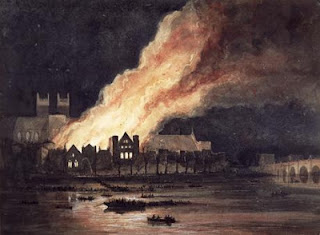 |
| Fire at Westminster Palace (more images at the end of the post) |
In my new book,
The Reluctant Duchess, one character is caught up in the fire at the Palace of Westminster. This wasn't just a plot point, Westminster palace did suffer a bad fire. Click any of the images to enlarge.
We all know that Guy Fawkes tried to destroy Parliament but what most people don't know is that, where he failed, two workmen succeeded! No bombs, no explosives, no flammable liquids. All it took these men was a bunch of sticks. Yes, sticks.
Before reading and writing was common, the Exchequer used tally sticks to keep track of debt. A stick was marked with grooves denoting ho much was owed, and the stick was then split don the middle, the Exchequer keeping half and the debtor keeping the other half. No two tally sticks would fit back together, except the two that had once been the same stick. This stopped people cutting extra grooves into a tally stick, or trying to make another with fewer grooves.
 |
| Old Westminster Palace |
In the early 1800s they were being phased out of use but the Exchequer had a lot f old sticks lying around. Rather than selling or giving them away as kindling, they decided to burn the, using the furnace at Westminster Palace.
On October 16th 1834, they finished putting these sticks in the furnace and clocked off for the day. The intense heat melted the copper lining on the flues that ran under the House of Lords, catching the floor of the chamber on fire.
By 6.30, the fire was visible to passers by and the fire brigade raced to the scene but they were too late. The house of Lords was well aflame and it had spread to St Stephens Chapel (the house of Commons) and the speakers house. They decided to sacrifice those buildings and concentrate on Westminster Hall, dousing it with water to prevent it catching fire. It worked, they saves Westminster Hall, though the rest of the palace was lost forever.
 |
| Westminster palace today |
At it.s height, the flames were visible from Windsor and it created enough light that you could read a newspaper 500 yards away (that's half a kilometre or a third of a mile).
The spectacle drew huge crowds, most of whom were cheering (recent laws such as the poor law which set up Workhouses, were very unpopular). It also drew artists, who flocked to capture the scene.
The Palace was rebuilt, of course, in the iconic image that we all know today but two parts of the Old Palace remain. Westminster hall, of course, but also Jewel Tower. Though not actually part of the palace, Westminster Abbey is on both pictures and should give you a frame of reference.
 |
| Drawing by Greive showing the destruction of the old Palace of Westminster, viewed from across the Thames. |
 |
| Drawn on Stone by William Heath from a sketch taken by him by the light of the Flames, at the end of Abingdon Street. |
 |
| By Hercules Brabazon Brabazon |
 |
A view from the Lambeth shore of the Houses of Parliament at the
height of the fire, the reflection dramatically lighting Westminster
Abbey and the river. A sailing barge and small boats crowded with
spectators in the foreground. By
David Hall McKewan |
 |
| The drawing shows the ruined interior of St. Stephen's Chapel, looking north, after the fire of 1834. G Moore |








No comments:
Post a Comment